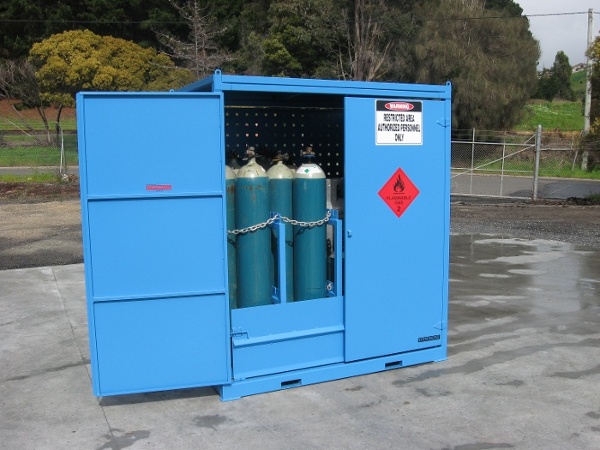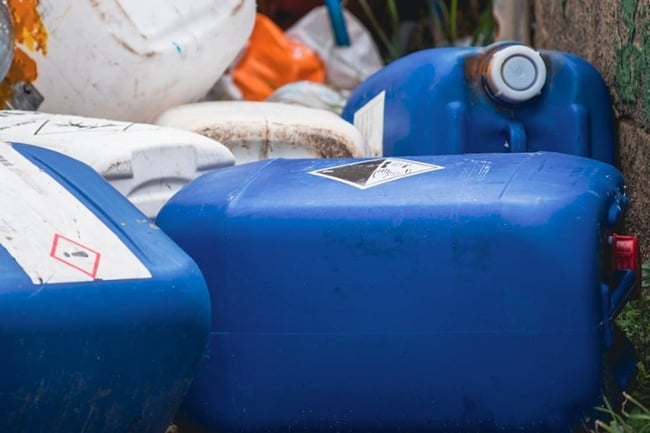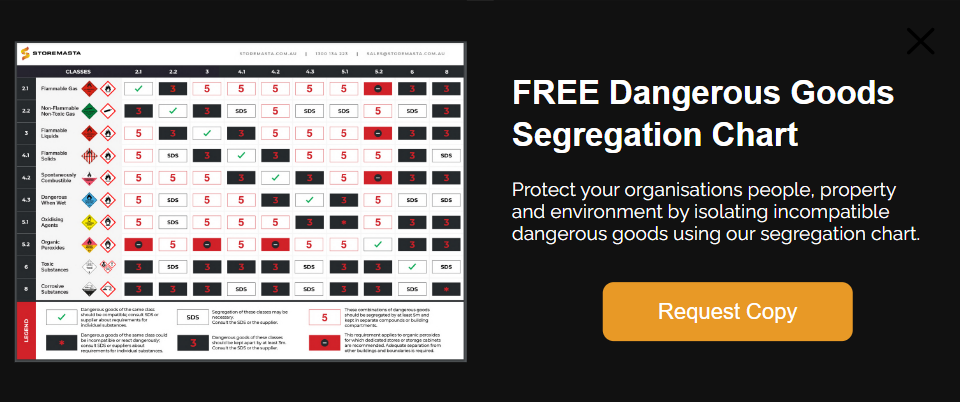Are you aware of the risks involved with storing flammable liquids with incompatible dangerous goods? If you’re carrying chemicals in your workplace, you must consider how incompatible classes of dangerous goods can react with your flammable liquids store. The incorrect storage of incompatible chemicals can result in violent chemical reactions that can cause casualties as well as destruction to property and the environment.

When considering storage for Class 3 Flammable Liquids, you must understand what dangerous goods they are incompatible with.
According to the recently updated Australian Standard for mixed classes of dangerous goods, AS 3833, there is a difference between substances that are incompatible and those that will react dangerously.
We’ll highlight these differences in detail now.
Incompatible Substances
Incompatible dangerous goods are those substances and articles that are:
- Likely to interact with other goods, increasing the risk when mixed or brought into contact with the dangerous goods;
- Listed in the Australian Dangerous Goods Code or the Australian Standard AS 3833; or
- Deemed by the regulatory authority as being incompatible.
Substances That React Dangerously
'React dangerously' refers to dangerous goods which create a hazard due to the reaction. Some examples of dangerous reactions include:
- Combustion
- Evolution of considerable heat
- Evolution of asphyxiant, toxic or flammable gases
- Formation of corrosive substances
- Formation of unstable substances

Flammable liquids must not be stored with incompatible dangerous goods that can cause a dangerous chemical reaction.
The Importance Of Chemical Segregation
Dangerous goods that are incompatible and react dangerously with flammable liquids require safe segregation. This can be achieved by storing the incompatible chemicals in separate safety cabinets or outdoor stores that are applicable for that class of dangerous goods.

One of the key functions of a Class 3 Flammable Liquids cabinet is to provide segregation from incompatible chemicals.
However, if flammable liquids and other incompatible substances are stored in a common area — without a safety cabinet or outdoor store — they must be segregated by certain distances to avoid dangerous reactions.
The segregation requirements are determined by the Australian Standard AS 3833 - The storage and handling of mixed classes of dangerous goods and are explained in detail below:
Class 2.1 - Flammable Gases
Flammable gases and flammable liquids are classed as incompatible. These classes of dangerous goods cannot be kept together. If these substances have to be stored in a common dangerous goods store, they will need to be kept apart, with the flammable gas requiring a sturdy gas cage to minimise the potential for harm.
This is due to these goods complicating fire response through radiant heat or reactivity issues.

Keep your gases away from flammable liquids, storing each type of goods in a store purpose-built for that division or class.
Class 2.2 - Non-Flammable, Non-Toxic Gases
Non-flammable non-toxic gases and flammable liquids are also classed as incompatible, as they pose a significant reactivity issue.
Isolation of Class 3 Flammable Liquids and Class 2.2 gases is required.
BEWARE: some non-flammable non-toxic gases are also oxidising gases. Oxidising gases and flammable liquids will react dangerously. For more information, refer to the section below that outlines the segregation requirements for storing oxidising agents and flammable liquids in a common dangerous goods store.
Class 2.3 - Toxic Gases
Toxic gases and flammable liquids are recognised as incompatible, as they pose a significant reactivity issue. Therefore, they must be isolated. We recommend dedicated gas cages and flammable liquids storage, separated from each other and isolated from any sources of heat or ignition.
Class 4.1 - Flammable Solids
Flammable solids and flammable liquids must be kept apart during storage. If flammable liquids and flammable solids must be stored in a common store, they shall be segregated sufficiently. Additional consideration must be given to the quantities stored and the fire risk.
Class 3 and Class 4.1 substances may complicate the fire response in the event of an emergency, therefore, isolation of these incompatible substances is required.

A risk assessment must be conducted if you are considering storing flammable solids with flammable liquids in an indoor dangerous goods storage cabinet as they are incompatible chemicals.
Class 4.2 - Substances Liable To Spontaneous Combustion
Class 4.2 dangerous goods and flammable liquids must not be kept together when stored due to significant reactivity issues that demand isolation.
IWe recommend individual Safety Cabinets (made for the particular class or division) for indoor storage to allow for segregation and isolation between these substances.
Class 4.3 - Substances Which In Contact With Water Emit Dangerous Gases
Class 4.3 dangerous goods and flammable liquids shouldn’t be kept together. Class 4.3 dangerous goods and flammable liquids have the potential to harm people and property, complicating fire response with radiant heat.
Class 5.1 - Oxidising Agents
Oxidising agents and flammable liquids have the potential to react dangerously. If flammable liquids are going to combust, they require a continuous supply of oxygen. In a combustion reaction, oxidising agents provide the necessary oxygen for flammable liquids to combust. Oxidising agents and flammable liquids must never be kept in a common store due to the risk of reactivity. Vapours and spills must be controlled and kept separated due to this reactivity issue.

Oxidising agents have the potential to react dangerously with flammable liquids and must be stored apart.
Class 5.2 - Organic Peroxides
Organic peroxides and flammable liquids will also react dangerously.
Therefore, Class 5.2 dangerous goods must be isolated from flammable liquids and stored in separate dangerous goods storage facilities. This isolated storage can be achieved by using relocatable chemical storage containers made for each separate class or separate dedicated indoor chemical storage cabinets.
Class 6.1 - Toxic Substances
Toxic substance and flammable liquids are incompatible. These two classes of dangerous goods must not be kept together. If flammable liquids and toxic substances are kept in a common dangerous goods storage facility, they must be separated.

Toxic substances are incompatible with flammable liquids and should be kept apart.
Class 8 - Corrosive Substances
Corrosive substances and flammable liquids must not be stored together. If these two classes of dangerous goods must be stored in a common dangerous goods store, they must be kept apart. However, due to the different requirements for storage, we recommend a dedicated Class 3 store for fire protection and a Class 8 store that provides protection from corrosion.

As incompatible chemicals, you must store corrosive substances and flammable liquids in isolation.
Class 9 Lithium-ion Batteries
Lithium-ion batteries have now been incorporated into the Australian Standard AS 3833 to assist with the segregation of these miscellaneous dangerous goods from flammable liquids and other dangerous goods.
Due to the fire risk of batteries, as well as that of Class 3 Flammable Liquids, they are regarded as having significant reactivity issues. Therefore, they must be isolated. We recommend dedicated battery storage cabinets or outdoor stores, with the flammable liquids stored in the appropriate compliant Class 3 storage. Of course, all ignition sources must be isolated from areas storing any types of flammable goods.
How are you Storing Incompatible Dangerous Goods?
As we’ve discussed in this blog, Class 3 Flammable Liquids will react dangerously with a multitude of other dangerous substances. Therefore, it’s vital that you apply the rules of chemical segregation when you’re storing flammable liquids with other classes of dangerous goods. However, keep in mind that choosing a compliant indoor storage cabinet or outdoor store that meets the requirements of the Australian Standards allows you to safely store your dangerous goods. This is because a compliant safety cabinet is specifically designed and constructed to provide risk control measures including chemical segregation.
Are you interested in learning more about the safe storage of dangerous goods? Our dangerous goods segregation chart is designed to help you identify which classes of dangerous goods require segregation. Access your copy today by clicking on the below image.
Joining the team as a Dangerous Goods Storage Consultant, Melissa Hampton became Storemasta's Marketing Manager in late 2021. With extensive knowledge and experience in chemical compliance, Melissa is responsible for leading the Marketing team and helping shape their marketing strategy. In her spare time, you can find Melissa hiking, swimming and enjoying the great outdoors in beautiful north-west Tasmania.
